Proper fit is crucial for performance and comfort in road cycling. Shoe sizes vary by brand, so understanding your foot shape and riding style ensures the best fit.
Why Proper Fit Matters in Road Cycling Shoes
A proper fit in road cycling shoes is essential for both performance and comfort. Ill-fitting shoes can lead to discomfort, numbness, or blisters, which can distract from your ride. A snug fit ensures efficient power transfer to the pedals, improving overall performance. Conversely, shoes that are too tight or too loose can hinder your ability to maintain consistent pressure, affecting control and speed. Additionally, proper fit reduces the risk of foot fatigue and pain during long rides. It’s important to consider how cycling shoes fit differently from regular shoes, as they are designed to support the unique demands of cycling. By prioritizing a precise fit, you can enhance your riding experience and prevent potential discomfort or injury. Always consult size charts and try shoes on to ensure the best fit for your needs.
Overview of the Road Cycling Shoe Size Guide
This guide provides a comprehensive approach to selecting the right road cycling shoes. It covers sizing variations across brands, the importance of foot shape and width, and how riding style impacts fit. The guide includes step-by-step measurement techniques and explains how to interpret size charts, comparing EU and US sizes. It also offers practical advice on trying shoes, identifying pressure points, and deciding when to size up or down. Examples from popular brands illustrate how sizing can differ, while tips on avoiding common mistakes ensure a comfortable and performance-enhancing fit. Whether you’re a seasoned cyclist or a beginner, this guide helps you navigate the complexities of shoe sizing to find your perfect match for optimal performance and comfort on the road.
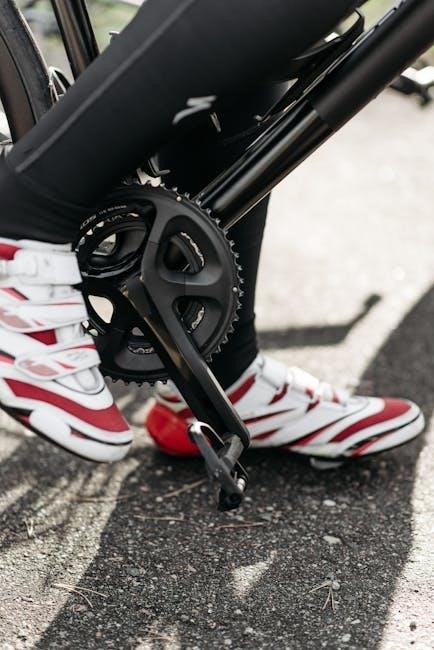
Factors Influencing Road Cycling Shoe Size
Brand sizing differences, personal foot shape, width, and riding style significantly impact shoe fit. Proper measurement and understanding these factors ensure optimal comfort and performance.
Differences in Brand Sizing and Fit
Each cycling shoe brand offers distinct sizing and fit profiles, influenced by shoe lasts and design philosophies. For instance, some brands cater to narrower feet, while others provide a roomier toe box. Understanding these variations is crucial for selecting the right shoe. For example, Bont Cycling shoes are known for their customizable fit, while brands like Shimano offer a more universal fit. Additionally, materials and construction play a role in how shoes mold to the foot over time. Consulting a size chart specific to each brand and considering personal comfort preferences are essential steps in finding the ideal fit. This ensures optimal performance and comfort during rides.
Importance of Personal Foot Shape and Width
Your foot shape and width significantly impact cycling shoe fit. Narrow or wide feet require specific shoe styles to avoid discomfort. Measuring both feet ensures accurate sizing. Using a size chart helps match your foot dimensions to the shoe. Proper fit prevents issues like toe compression or heel slippage, enhancing performance and comfort. Considering foot shape ensures optimal support and alignment, reducing the risk of discomfort or injury. This personalized approach guarantees a better fit, making your cycling experience more enjoyable and effective.
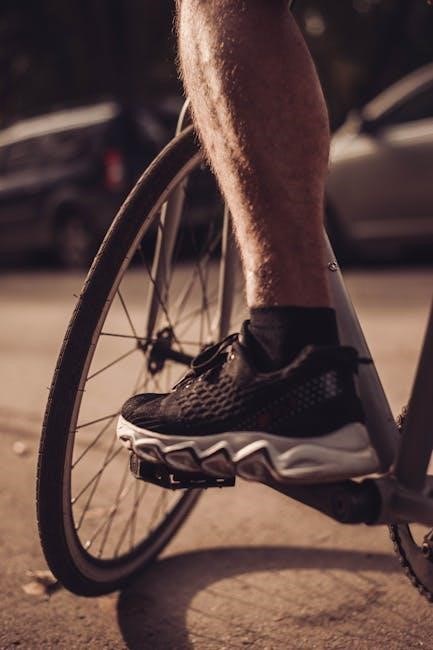
How Riding Style Impacts Shoe Fit
Your riding style plays a significant role in determining the ideal fit for cycling shoes. Aggressive riders or those with a more aerodynamic position may prioritize a snug fit to prevent foot movement, while casual riders might prefer a bit more comfort. The type of riding, such as road, mountain, or triathlon, also influences fit preferences. For example, road cycling often requires a more precise fit due to high-intensity efforts, whereas comfort over long distances may be key for endurance riders. Understanding your riding style helps you choose shoes that balance performance and comfort, ensuring optimal support and alignment during your rides.
Measuring Your Feet for Accurate Sizing
Accurate foot measurement is essential for selecting the right road cycling shoe size. Start by measuring both the length and width of your feet, as size isn’t solely determined by length. Use a ruler or Brannock device for precision. Trace your foot on paper to create an outline, measuring from the heel to the longest toe for length and across the ball for width. Ensure measurements are taken while standing, as feet swell during the day. Consider the time of day, as feet expand slightly, making evening measurements more accurate. Check brand-specific size charts, as fits vary. Consider riding style: snug for aggressive racing, or more room for endurance. Material differences, like stiff carbon soles, may also affect fit. If using insoles, you might need a half size up. Trying shoes on or reviewing size comparisons can aid in making the best choice for comfort and performance.

How to Measure Your Feet for Cycling Shoes
Measure your feet while standing using a ruler or Brannock device. Trace your foot outline to determine length (heel to longest toe) and width (across the ball).
Step-by-Step Guide to Measuring Foot Length
To measure foot length accurately, start by placing your foot flat on the floor. Use a ruler or Brannock device to find the longest point of your foot, typically the big toe. Ensure your foot is in a natural position, as if standing. Measure from the back of the heel to the tip of the longest toe. Record this length in centimeters or inches. This measurement will help determine your shoe size, but remember to account for any differences in brand sizing. For the most accurate fit, measure both feet, as they may differ slightly. Repeat the process to ensure consistency and reliability in your measurements.
Measuring Foot Width for the Best Fit
Measuring foot width is essential for ensuring optimal comfort and performance in road cycling shoes. To measure width accurately, place your foot flat on the floor and use a ruler to find the widest part, typically across the ball of the foot. Record this measurement in centimeters or inches. Foot width can vary significantly, and many brands offer options for narrow, standard, or wide fits. Comparing your width measurement to the brand’s size chart will help you select the most comfortable shoe. Keep in mind that foot width may change slightly during the day, so measuring in the afternoon is often more accurate. Consistent measuring ensures the best fit, as cycling shoes should feel snug but not constricting.
Considering Toe Shape and Foot Arch
Toe shape and foot arch play significant roles in selecting road cycling shoes. People with different toe shapes—such as square, round, or tapered—may prefer varying shoe shapes to avoid discomfort. A square toe box allows toes to sit naturally, reducing pressure. Foot arch, whether high, medium, or flat, influences shoe choice. Riders with high arches may benefit from shoes with built-in support or customizable insoles, while those with flat feet might prefer stiffer shoes for stability. Assessing these factors helps in choosing a shoe that aligns with your foot’s natural structure, enhancing comfort and performance during rides. Brands often design shoes with specific arch support, so matching your arch type to the shoe’s features is crucial for optimal fit and pedaling efficiency.
Understanding Road Cycling Shoe Size Charts
Size charts help riders match foot measurements to shoe sizes, considering length and width. Each brand offers specific fits, so comparing charts ensures accurate sizing for comfort and performance.
EU vs. US Size Conversions for Cycling Shoes
Understanding EU and US size differences is crucial for selecting the right cycling shoes. EU sizes are typically smaller than US sizes, with a difference of about 1-2 sizes. For example, a US size 9 often corresponds to an EU size 42 or 43. However, exact conversions vary by brand, as some may align more closely with one standard over the other. To ensure accuracy, always refer to the specific brand’s size chart, as they may diverge slightly from standard conversions. Trying shoes on is recommended, as fit preferences can vary. Keep in mind that cycling shoes often run narrower and snugger than regular shoes, so sizing down by a half or full size is common for optimal performance and comfort.
How Cycling Shoe Sizes Compare to Regular Shoes
Cycling shoes often fit differently than regular shoes due to their specialized design. They are typically narrower and snugger to provide support and efficiency during pedaling. While regular shoes may allow for a looser fit, cycling shoes prioritize a secure, comfortable hold to prevent movement that could cause discomfort or affect performance. Many cyclists find they need to size down by a half or full size compared to their regular shoes. Additionally, cycling shoes may have a stiffer sole and a more contoured fit, which can feel tighter at first but is designed to optimize power transfer. It’s important to try them on with the same type of socks you plan to ride in to ensure the best fit.
Using a Size Chart to Find Your Perfect Fit
A size chart is an essential tool for selecting the right cycling shoes. Start by measuring your foot length and width accurately, as shown in the guide. Compare these measurements to the chart provided by the brand, keeping in mind that sizes can vary between brands. Pay attention to both length and width to ensure a comfortable fit. If you’re between sizes, consider your personal preference for a snug or roomier feel. Some charts also offer options for different foot shapes, so choose the one that best matches yours. Finally, use the chart to determine your size and order confidently, knowing you’ve taken the steps to find a fit that supports your performance and comfort on the road.

How to Choose the Right Fit for Road Cycling
Selecting the right fit involves balancing comfort, support, and performance. Ensure snugness without pressure points, allowing toes to move slightly for optimal comfort during long rides.
Trying On Shoes: What to Look For
When trying on cycling shoes, ensure a snug fit with minimal movement. Check for pressure points, especially around the toes and heel. The shoe should feel secure without discomfort. Pay attention to the width and how it accommodates your foot shape. If between sizes, consider the brand’s fit tendencies. Wear the same type of socks you plan to use while riding to ensure accuracy. A proper fit should allow toes to wiggle slightly but not slip excessively. If possible, try shoes on later in the day, as feet tend to swell. Comfort and support are key for long rides and optimal performance.
Pressure Points and Comfort in Cycling Shoes
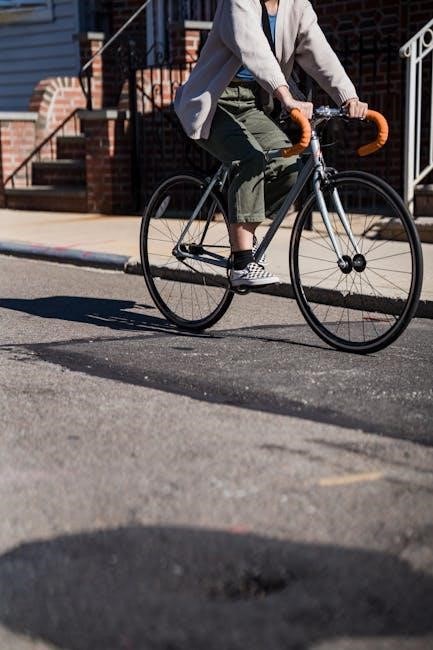
Pressure points can significantly impact cycling comfort and performance. Properly fitted shoes should distribute pressure evenly, avoiding hotspots that can lead to discomfort or pain during rides. Pay attention to areas around the ball of the foot and the heel, as these are common pressure zones. Shoes with adjustable closures allow for customized fit, reducing the likelihood of pressure points. Additionally, consider the stiffness of the sole and how it supports your arch. If pressure issues persist, insoles or orthotics may be necessary; Ensuring comfort and minimizing pressure points are essential for maximizing efficiency and enjoyment during long cycling sessions.
When to Size Down or Up for Optimal Fit
Determining whether to size down or up in cycling shoes depends on personal comfort and specific fit needs. If your shoes feel too tight, especially around the toes, consider sizing up for a more comfortable fit. Conversely, if there’s excessive room or your foot slides during rides, sizing down may provide the necessary stability. It’s important to try shoes on and assess how they feel during different riding positions. Some riders prefer a snug fit for performance, while others prioritize comfort for long rides. Pay attention to how your feet feel after extended periods and adjust your size accordingly to avoid discomfort or numbness.
Using the Road Cycling Shoe Size Chart
Align your foot measurements with the size chart to find your ideal fit, considering brand-specific variations for accurate sizing and optimal comfort.
Interpreting the Chart for Your Foot Measurements

To accurately interpret the size chart, start by matching your measured foot length and width to the corresponding size. Pay attention to brand-specific fits, as sizing can vary. Ensure your foot length aligns with the chart’s length measurements, leaving a small gap (about 1-2 mm) for toe movement. For width, select a size that accommodates your foot without causing pressure points. If your foot shape is narrower or wider than average, consider brands offering tailored fits. Snugness is key in cycling shoes, but avoid tightness that could restrict circulation. Use the chart to compare EU and US sizes, and note any special features like adjustable straps or customizable insoles. Testing the fit is essential to confirm comfort and performance.
- Match length and width to the chart.
- Consider brand-specific variations.
- Ensure a snug yet comfortable fit.
Examples of Size Selection for Different Brands
Different brands offer varying fits, so comparing size charts is essential. For instance, Brand A might run slightly larger, while Brand B offers a narrower fit. If you typically wear a US 10 in Brand A, you might need a 9.5 in Brand B. Additionally, some brands provide width options, which can significantly impact fit. For example, a rider with a wide foot may prefer Brand C, which offers a roomier toe box. Always refer to the specific brand’s size guide and consider downloading their measurement templates for accuracy. Testing shoes in person, if possible, ensures the best fit. Remember, optimal performance and comfort depend on selecting the right size for your foot shape and brand.
- Brand A: Runs larger, size down by 0.5.
- Brand B: Narrower fit, choose same size.
- Brand C: Wider options available.
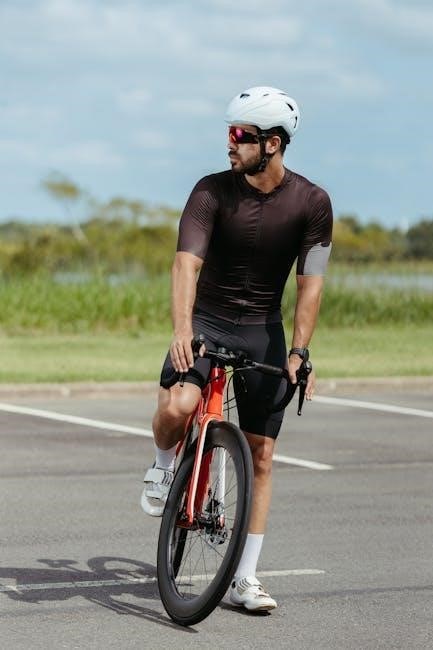
Common Mistakes in Choosing Road Cycling Shoes
Many cyclists overlook proper sizing, leading to discomfort. Ignoring foot width and relying solely on length can cause poor fit. Always measure accurately and try shoes on for optimal comfort and performance.
Mistakes to Avoid When Sizing Cycling Shoes
One common mistake is not considering foot width, as most brands offer varying widths. Another error is relying solely on regular shoe sizes, which often differ from cycling sizes. Some riders neglect to measure both feet, as they may vary slightly. Additionally, not accounting for personal foot shape, such as arch height or toe alignment, can lead to discomfort. It’s also crucial to avoid guessing sizes without consulting a size chart or trying shoes on. Proper fit is essential for performance and comfort, so taking the time to measure accurately and try shoes ensures a better riding experience.
Solutions for Poor Fit and Discomfort
To address poor fit, consider trying different sizes or brands, as sizing can vary significantly. Custom insoles can help alleviate discomfort by providing additional support or cushioning. If shoes feel too tight, opting for a wider fit or a different brand with a more forgiving design may resolve the issue. For riders with unique foot shapes, some brands offer customizable options or different “lasts” to better accommodate various arch types and toe configurations. Additionally, ensuring proper cleat placement can improve comfort and reduce pressure points. Trying shoes on in person is highly recommended to guarantee the best fit, and consulting with a professional fitter can also provide tailored solutions for optimal performance and comfort.
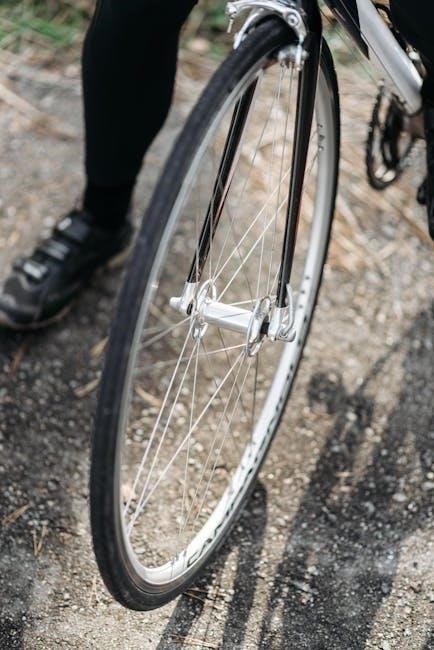
Additional Considerations for Road Cycling Shoes
Beyond size, consider insoles for customization, differences between road and other cycling shoes, and how shoe features like stiffness impact performance and comfort during rides.
Insoles and Customization for Better Fit
Insoles can significantly enhance comfort and performance in road cycling shoes by addressing specific foot needs such as arch support and cushioning. Many cyclists opt for custom insoles tailored to their foot shape, especially if they have flat feet or high arches. These insoles can help reduce hotspots and prevent discomfort during long rides. Additionally, some brands offer customizable shoe options where the fit can be adjusted to accommodate different foot widths or toe shapes. Using a size chart and trying on shoes with various insoles can help determine the best combination for optimal fit and performance.
Difference Between Road and Other Cycling Shoes
Road cycling shoes are designed for efficiency and speed, typically featuring stiff soles and cleats for optimal power transfer. Unlike mountain or casual cycling shoes, road shoes prioritize minimal weight and aerodynamics. They often have a snug fit and are tailored for performance, with less emphasis on walking comfort. Mountain bike shoes, in contrast, offer more rugged designs with better traction for off-road conditions. Casual cycling shoes may resemble sneakers, providing flexibility for everyday use. Understanding these differences helps cyclists choose the right shoe for their specific needs, ensuring both performance and comfort. Road shoes are a key investment for serious cyclists, offering unique benefits that set them apart from other cycling footwear.
Proper fit is key to performance and comfort. Consider brand variations and foot shape. Investing time ensures the optimal cycling experience for enthusiasts.
Final Tips for Finding the Perfect Road Cycling Shoe
Always prioritize proper fit for optimal performance and comfort. Try shoes on with cycling socks and ensure snugness without pressure points. Consider foot shape, toe box space, and riding style. Use brand-specific size charts, as EU and US sizes may differ. Measure feet regularly, as size can change over time. Pay attention to width options for a better fit. Test shoes during your usual riding time to ensure comfort. Don’t hesitate to seek advice from experts or reviews. Remember, the right fit enhances efficiency, reduces discomfort, and improves overall cycling enjoyment. Invest time in finding your ideal shoe to maximize performance and comfort on every ride.
Importance of Proper Fit for Performance and Comfort
A proper fit in road cycling shoes is essential for both performance and comfort. Ill-fitting shoes can lead to discomfort, reduced power output, and even health issues like numbness or blisters. Snug yet breathable shoes allow for efficient energy transfer during pedaling, enhancing speed and endurance. Proper fit also prevents foot fatigue, enabling longer rides without discomfort. Additionally, well-fitting shoes provide better control over the pedals, improving overall cycling efficiency and safety. Ensuring the right fit also supports foot health, reducing the risk of injuries. Therefore, investing time in finding the perfect fit is crucial for maximizing performance and enjoying a comfortable ride. A well-fitted shoe is a cornerstone of an enjoyable and effective cycling experience.
